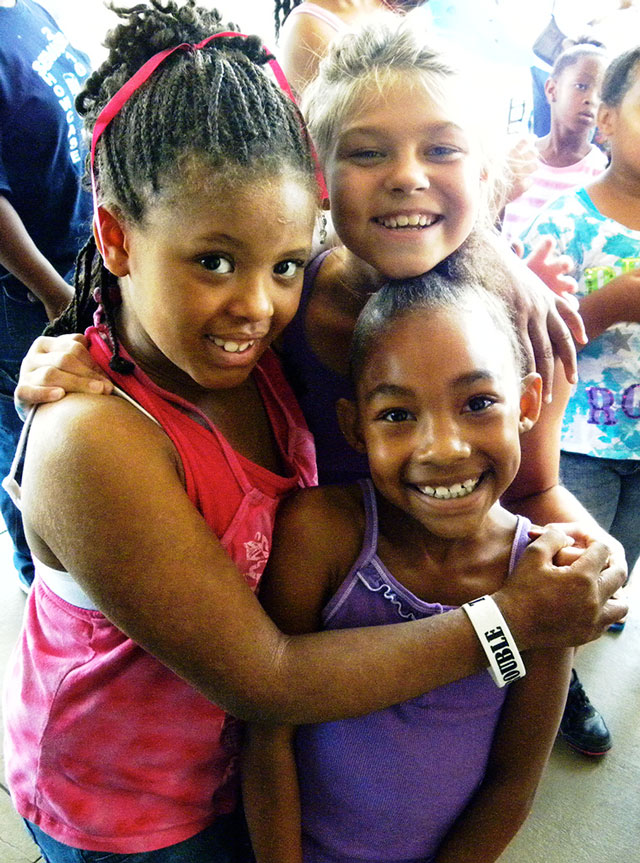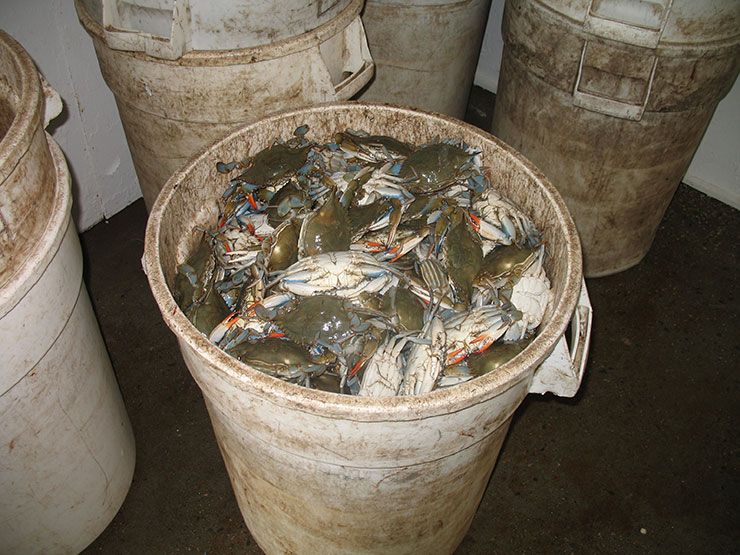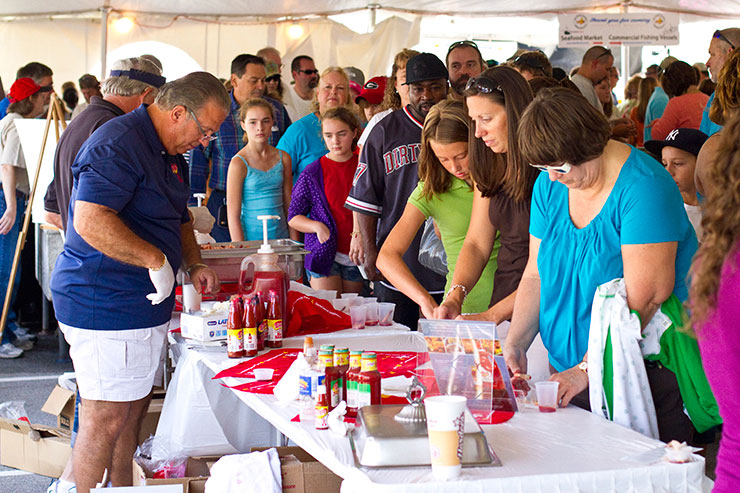Advancing Environmental Literacy: Informal Educators Add New Technology to Teaching Toolboxes

“If you ever want to see a bunch of grown people turn back into the wondrous, excited children they must have been, just put them in a pair of waders and let them interact with belugas and excellent trainers.” — Elizabeth Baird, education director, North Carolina Museum of Natural Sciences, Marine Mammal Institute blog
The beluga, a social, circumpolar whale called the “canary of the sea” because of its varied vocalizations, often amazes humans, as do fur seals, dolphins and other marine mammals.
Two groups of North Carolina informal educators experienced that excitement firsthand through 10 days of training — one group in 2010, one in 2011 — with the Marine Mammal Institute, participating in face-to-face encounters with belugas and other marine mammals at Atlantic seaboard museums and aquariums.
“I hope the enthusiasm we all feel for this topic will be translated to the families and students that attend our events,” Terri Kirby Hathaway, North Carolina Sea Grant’s marine education specialist, says.
The informal educators’ odyssey of aqueous professional development included a dolphin necropsy observation, and open-ocean dolphin and humpback whale-spotting research. They also learned about new educational technology, including the GeoDome, a freestanding, inflatable audience-immersive video theater, 25 feet in diameter and about 15 feet high.
Through the N.C. Aquarium Society, Baird and Peggy Sloan, N.C. Aquarium at Fort Fisher’s director, landed the MMI grant, which included two GeoDomes, designed and built by The Elumenati of Asheville. When not on tour, one dome is at the museum in Raleigh, one at the Fort Fisher aquarium.
Hundreds of educators and students statewide are participating in GeoDome-based events, thanks to funding from the National Oceanic and Atmospheric Administration’s Environmental Literacy Grant Program.
The informal educators — who share information in learning environments such as aquariums, museums and zoos, as well as nature and science centers — describe their marine mammal experiences and explain how such animals are faring during our era of climate change.
They also share materials they created or adapted to develop climate and ocean literacy with other informal educators. The lessons complement the GeoDome video presentation. Each MMI educator is required to plan, host and conduct a marine mammal event in the year following their training.
HANDS-ON LEARNING
Case in point: The Museum of the Albemarle’s “Summer Fun: Day at the Beach” program, where youngsters happily follow a paper-beluga-bedecked string trail on the museum floor to rooms filled with sea treasures.
Kirby Hathaway piggybacked her marine mammal program on this already-scheduled event in Elizabeth City, creating learning stations for all ages. Some of the materials were picked up during last year’s MMI training.
Sara Jean Hallos, N.C. Coastal Federation’s coastal outreach specialist and one of this year’s trainees, introduces visitors to marine mammal “biofacts.” The word was coined in 1993 to refer to preserved items such as animal bones, skins, molts and eggs. The visitors, young and old, see and touch a whale’s preserved eyeball, basting-brush-like baleen, a humpback whale’s skeletal phalange (finger bone) and huge hipbone. They also see dolphin parts, including jawbones, backbone and ribs, a sealskin and more.
And on the spacious, breezy portico overlooking the Pasquotank River, museum junior docents, supervised by Charlotte Patterson, the MOA’s education coordinator, help make kites, sand-filigreed picture frames decorated with tiny seashells, toy wooden sailboats, porpoise headbands and sand drums.
At the end of the paper-beluga trail, Kirby Hathaway, with museum staff and volunteers, has laden four tables with activities related to marine mammals. Here, visitors discover how whales and walruses keep warm in chilly waters and what marine mammals might eat.
To learn about insulation, visitors insert one hand into a small plastic bag inside another that contains solid cooking shortening, which shares blubber’s thermal properties. Immersing the protected hand and the bare hand into a tub of ice water, the students note which chills more quickly. Hint: It’s the one that’s not insulated.

Then they examine the simulated stomachs of bottlenose dolphins and other marine mammals. The contents, suspended in a viscous, kid-attracting white polymer called Gak — a glue and borax mix — reveal what the animals have “eaten.” Students probe the sticky mess, turning up “squid,” “octopus” and other replicated items, such as garbage from the ocean. That’s the lesson’s objective: Ocean trash goes down marine mammals’ hatches.
Before the day is over, more than 300 visitors will have learned how climate change affects mammals that live in the world’s oceans. They learned through interactive lessons and the companion video they viewed in the seemingly mysterious, black GeoDome, the program’s biggest draw. The dome’s dark inner wall forms an almost-wraparound screen — a mini-IMAX of sorts — which displays images of polar bears, sea lions and various marine mammals now facing climate change’s effects on their habitats.
The presentation includes cold-water animals such as fur seals and polar bears because, “although it is a global phenomenon, the effects of climate change at present are more evident at the poles,” Sloan notes.
“And the GeoDome allows us to provide a portable theater for an interactive presentation in almost any venue,” she adds.
Portable may be the operant word here.
Sloan and Baird each are transporting a dome to eight locations this year and eight more in 2012. That’s 32 sites in two years.
The educators will use the GeoDomes to communicate climate change impacts long beyond the current project’s life, Sloan says. “Software created for this presentation can be used in other GeoDomes and was designed with the intent to adapt for use with NOAA’s SOS — Science on a Sphere — and Ocean Today technology,” she explains. The N.C. Aquarium on Roanoke Island already hosts an SOS, a 6-foot diameter, computer-driven image display projected on a globe.
Not every educational venue can afford permanent GeoDome-level technology, however, so the MMI training is a boon not only to the trainees, but also to educators at other sites.
Educational coordinators at museums and other sites appreciate the results of the MMI training, and the GeoDome in particular.
“The MMI is vital to our area in bringing marine education events to museums and other venues that would not have been able to stage such high-tech educational programs,” Patterson says. “The GeoDome presentation was a marvelous opportunity that children in our area would not have been able to experience otherwise due to budget constraints by our facility and by the families we service. We reached groups from the Boys and Girls Club, Girls Inc., summer care programs, teen camp at Elizabeth City State University and the public.”
Baird, whose vantage point inside the dome makes for some interesting listening, hears direct feedback.
For instance, she asks a group after the MOA show: “Does it matter if we lose polar species?”
“Yessss!” the kids respond.
“Would we want to?”
“Nooooo,” they chorus.
Visitors were equally enthusiastic at the North Carolina Zoo in Asheboro in April, where 246 high schoolers and 18 teachers attended GeoDome programs.
“The GeoDome was beyond popular with the students,” says Steve Gerkin, zoo visitor educator, who noted a few visitor comments:
• “I did not know how much climate change impacts everything!”

• “The food chain in the Arctic is messed up. We need to do something to help!”
• “I’m not going to idle my car anymore.”
• “When I buy items, I am going to look for recycled ones.”
• “I am going to talk to other people about recycling and reducing electricity use.”
• “The movie surrounded me.”
• “The GeoDome made it seem like I was there.”
In Charlotte, Discovery Place’s World Ocean Day in June attracted about 1,000 people, including 500 mostly middle-school students, two early-childhood school groups and youngsters attending with their parents, educator Juliann Chavez says.
“The teachers there loved the activities and asked about using them for a climate change unit at their school,” adds Chavez, who, along with Gerkin and Kirby Hathaway, attended MMI’s 2010 training.
MMI TRAINING REDUX
The second MMI cohort’s classes — hands-on and sometimes hands-on-fins or -teeth — continued this summer. Except for an additional visit to the newly opened Jennette’s Pier at Nags Head, the route was the same as last year’s, including the N.C. Aquarium on Roanoke Island and the Virginia Aquarium in Virginia Beach.
In D.C., the group visited the Sant Ocean Hall at the Smithsonian Institution’s Museum of Natural History, where they learned about the scope of NOAA technologies, and the Koshland Science Museum of the National Academy of Science.
At the National Aquarium in Baltimore, they learned about dolphin behavior and at the Mystic Aquarium in Connecticut, they encountered belugas.
Last year, Kirby Hathaway blogged from Mystic, Conn.:
“At the first station, we worked with trainer Kim and Kela, a 29-year-old female beluga. We each patted her tongue, used hand signals to have her make different vocalizations, and felt her teeth. Then we worked with trainer Kristina and Naku, another 29-year-old female. This time, we got in the water with Kristina and Naku — we each got to pet her tongue, splash water in her face and get splashed in return and touch her melon (which felt like a hard-boiled egg and is most likely used in sound production.) Most of us got very wet with the splashing, and we all were overwhelmed with the emotions of getting so close to such magnificent animals.”
The educational journey also included lessons at the New England Aquarium in Boston, from which they set out for Stellwagen Bank and close encounters with fin and humpback whales in the wild.
MMI training produced an educational ripple in the ocean of knowledge that is spreading from educator to educator to learners.
“One of the unexpected outcomes of the MMI experience,” Baird says, “was the strong collaborative bands that have developed among the educators from across the state. By tapping into each other’s knowledge and resources, everyone has had stronger events.”
Kirby Hathaway concurs.
“Being thrown together on a bus for 10 days gave us the opportunity to get to know each other very well, very quickly,” she says. “Those friendships morphed into professional connections that continue to grow and make us all better educators. Our students — from K to gray — all benefit from our shared experience.”
LEARN MORE
This article was published in the Autumn 2011 issue of Coastwatch.
For contact information and reprint requests, visit ncseagrant.ncsu.edu/coastwatch/contact/.


